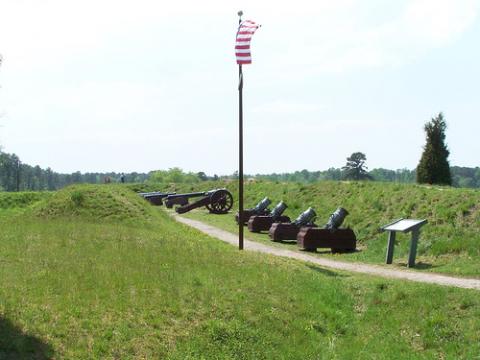I don't know of anyone who is happy about the current economic situation, but while we're waiting for a turn-around, here's a question to ponder: Can a bad economy ever be good for parks?
In at least one case, the answer seems to be "yes," because the Great Depression played a key role in saving the Yorktown Battlefield from private development.
Back in the mid-1920s, prosperous Americans were becoming increasingly interested in leisure activities, and good train service, a growing highway network and budding air travel made weekend trips more practical for the well-heeled. A sleepy historic village in southeastern Virginia caught the attention of real estate developers looking for a site for a golf-based resort.
The gently rolling terrain, view of the nearby York River, and relative proximity to large population centers made the area a fine site for the Yorktown Country Club, and at that time the place where America finally achieved victory in its quest for independence from Great Britain was still in private ownership.
In 1926 the 18-hole Riverview Golf Course was constructed around the earthworks remaining from the Civil War and Revolutionary War on the Yorktown Battlefield, and work was begun on a large hotel. The Great Depression halted construction on the hotel in 1929 and ended plans for a second golf course on the battlefield.
Colonial National Monument (later renamed Colonial National Historical Park) was established the following year, and the NPS acquired the former country club property. The present-day Yorktown Visitor Center stands on the site of the hotel.
If you visit the area today and stand close to the tree line near Redoubts 9 and 10, you might notice a small area of raised ground. To the casual observer, the spot could appear to be an overlook of sorts, providing a view of the York River and battlefield. I'm told on good authority it's actually the tee for one of the holes on the former golf course. Those sweeping vistas across mowed fields? They were once fairways for the golfers.
Americans can be grateful the previous owners didn't simply bulldoze the historic earthworks in the early years of the project. We'll never know how much additional development would have eventually occurred on the battlefield if the financial crash hadn't occurred when it did, but from the standpoint of historic preservation, this is one case where a bad economy proved to have at least one very positive effect.




Comments
Great article, Jim!
Far too many of the Virginia Battlefields have been lost to developement over the years, and it would have indeed been a travesty for an area as important as the Yorktown site to have been turned into a golf course, of all things.
I can point out two very different preservation plans for battlefield sites in Henrico County, Virginia, both actually located along US Rt. 1. There is a privately owned set of earthworks that exists smack in the middle of a fairly large strip mall, near where "Brook Run" creek goes under Rt. 1. These works were part of the outermost fortifications of this city of Richmond, and saw a fair amount of action during both Kilpatricks raid and Sheridans Battle at Yellow Tavern. This site was painstakingly presevered during the entire construction process, and boasts a masonry placard, fencing, and a set of illuminated flagpoles given to the site and dedicated by the Daughters of the Confederacy. It is well a maintained, visually pleasing site, just across from a fitness center and a large grocery store.
Just a handful of miles North of this area is the "Yellow Tavern" battlefield site, where JEB Stuart received his mortal wound. There is a monument on the spot where Stuart was shot, if you can find it amongst the urban sprawl. The battlefield itself, once owned by the Terrell family and renamed "Bleak Hill Farm" after the devestation caused by the battle, is now the site of a huge shopping mall complex. JC Penny, Macy's, etc., won that battle against preservation.